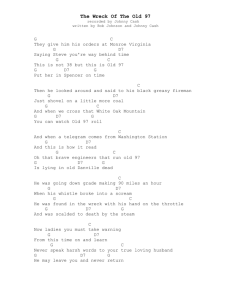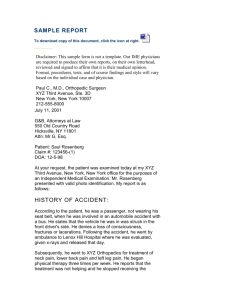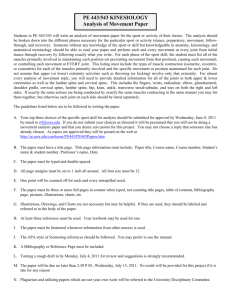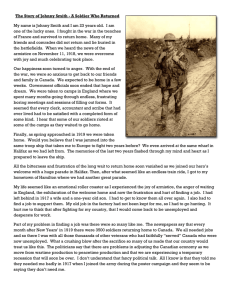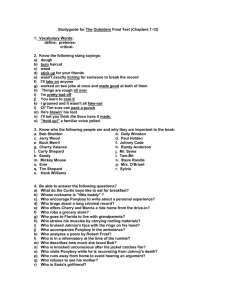Coahila v Shahzad - Unified Court System
advertisement
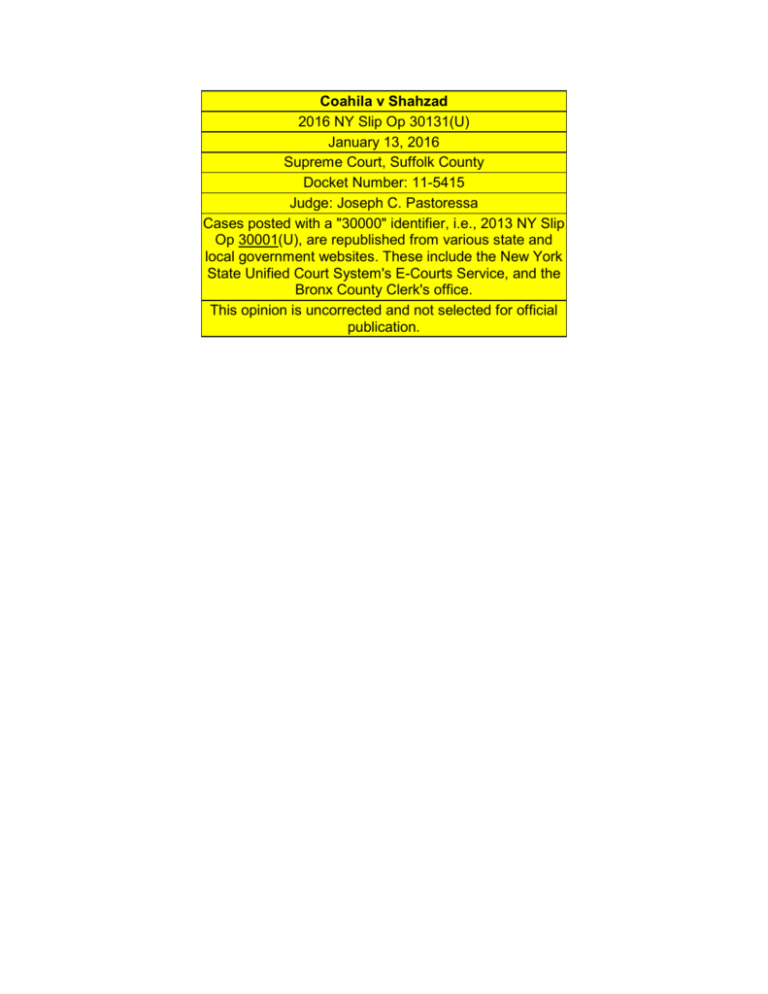
Coahila v Shahzad
2016 NY Slip Op 30131(U)
January 13, 2016
Supreme Court, Suffolk County
Docket Number: 11-5415
Judge: Joseph C. Pastoressa
Cases posted with a "30000" identifier, i.e., 2013 NY Slip
Op 30001(U), are republished from various state and
local government websites. These include the New York
State Unified Court System's E-Courts Service, and the
Bronx County Clerk's office.
This opinion is uncorrected and not selected for official
publication.
[* 1]
SHORT FORM ORDER
INDEX No. --=-1""-1-""'""54-'-'1=5_ _
CAL. No.
I4-00257MV
SUPREME COURT - STATE OF NEW YORK
T.J\.S. PART 34 - SUFFOLK COUNTY
PRESENT:
Hon.
JOSEPI I C. PASTORES SA
Justice of the Supreme Court
---------------------------------------------------------------X
JOI INNY and JUDITH COAHILA,
Plaintiffs,
MOTTON DATE 4-3-14 (#005)
MOTION DATE 5-18-15 (#006)
ADJ. DATE
5-20-15
Mot. Seq. # 005 - MD
# 006-XMD
JJAROLD A. SIIAPIRO, ESQ.
Attorney for Plaintiffs
320 Carleton Avenue, Suite 6200
Central Islip, New York 11722
- against MUHAMMAD A. SHAHZAD and NIRVA
ARIOL,
MARTYN TOHER MARTYN & ROSSI
Attorney for Defendants
330 Old Country Road, Suite 211
Mineola, New York 1150 I
Defendants.
---------------------------------------------------------------X
Upon the following papers numbered l to __1L read on this motion for summary judgment ; Notice of Motion/ Order to
Show Cause and supporting papers .J...:....fQ...; Notice of Cross Motion and supporting papers_; Answering Affidavits and supporting
papers 21 - 26; Replying Affidavits and supporting papers 27 - 28 ; Other_; (aud afte1 hearing etmnsel i11 sttpport and opposed
to the 111otio11) it is,
ORDERED that the motion by the defendants for summary judgment dismissing the complaint on the
ground that the plaintiffs did not sustain serious injuries as defined in Insurance Law§ 5102 (d) is denied; and
it is further
ORDERED that the cross motion by the plaintiffs for summary judgment in their favor on the ground
that they did sustain serious injuries as defined in Insurance Law § 5102 (d) is denied.
The plaintiffs commenced this action to recover damages for injuries they allegedly sustained as a
result of a motor vehicle accident that occurred at the intersection of Suffolk J\ venue and Bergen Street in
the Town oflslip on September 5, 2009. It is alleged that the accident occurred when the vehicle operated
by defendant Muhammad Shahzad and owned by defendant Nirva ArioJ collided with the vehicle operated
by plaintiff Johnny Coahila. The following is undisputed. At the time of the accident, plaintiff Judith
Coahila was riding as a front scat passenger in the Coahila vehicle. Prior to the subject accident, the
plaintiffs were involved in an unrelated vehicle accident in 2006. As a result of the 2006 accident, Johnny
Coahila underwent knee surgery, although he had no recollection as to which knee was injured.
I3y their bill of particulars, the plaintiffs allege that, as a result of the subject accident, Johnny
Coahila sustained serious injuries including bulging discs at C2-C3, C3-C4, and C6-C7; cervical radiculitis
[* 2]
Coahila v Shahzad
Index No. 11-5415
Page No. 2
at C5-C6; and tears of the medial and lateral meniscus in the right knee. Johnny Coahila claims that,
following the subject accident, he underwent right knee surgery in February 20 I 0, and that he was unable to
return to work for approximately three months. The plaintiffs allege that, as a result of the subject accident,
Judith Coahila sustained serious injuries including bulging discs at C2-C3, C5-C6, C6-C7, and L2-L3
through L5-S 1; cervical radiculitis; cervical sprain/strain; and bilateral shoulder tendonitis.
The defendants now move for summary judgment dismissing the complaint on the ground that the
plaintiffs did not sustain serious injuries as defined in Insurance Law § 5102 (d).
Insurance Law § 5102 (d) defines "serious injury" as "a personal injury which results in death;
dismemberment; significant disfigurement; a fracture; loss of a fetus; permanent loss of use of a body
organ, member, function or system; permanent consequential limitation of use of a body organ or
member; significant limitation of use of a body function or system; or a medically determined injury or
impairment of a non-permanent nature which prevents the injured person from performing substantially
all of the material acts which constitute such person's usual and customary daily activities for not less than
ninety days during the one hundred eighty days immediately following the occurrence of the injury or
impairment."
In order to recover under the "permanent loss of use" category, plaintiff must demonstrate a total
loss of use of a body organ, member, function or system (Oberly v Bangs Ambulance, 96 NY2d 295). To
prove the extent or degree of physical limitation with respect to the "permanent consequential limitation of
use of a body organ or member" or a "significant limitation of use of a body function or system" categories,
either a specific percentage of the loss ofrange of motion must be ascribed, or there must be a sufficient
description of the "qualitative nature" of plaintiff's limitations, with an objective basis, correlating
plaintiff's limitations to the normal function, purpose and use of the body part (see Perl v Meher, 18 NY3d
208). A minor, mild or slight limitation of use is considered insignificant within the meaning of the statute
(Licari v Elliott, 57 NY2d 230).
On a motion for summary judgment, the defendant has the initial burden of making a prima facic
showing, through the submission of evidence in admissible form, that the injured plaintiff did not sustain a
"serious injury" within the meaning of Insurance Law § 5102 (d) (sec Gaddy v Eyler, 79 NY2d 955; Akhtar
v Santos, 57 AD3d 593). The defendant may satisfy this burden by submitting the plaintiffs own
deposition testimony and the affirmed medical report of the defendant's own examining physician (sec
Moore v Edison, 25 AD3d 672; Farozes v Kamran, 22 AD3d 458). The failure to make such a prima facie
showing requires the denial of the motion regardless of the sufficiency of the opposing papers (sec
Winegrad v New York Univ. Med. Ctr., 64 NY2d 85 l , 853; Boone v New York City Tr. Auth .. 263 J\D2d
463).
Herc. the defendants failed to make a prima facic showing that Johnny Coahila did not sustain a
serious injury within the meaning oflnsurancc Law § 5102 (d) (sec Reitz v Seagate Trucking. Inc., 71
J\D3d 975). On February 5, 2013, approximately three years and five months after the subject accident, the
moving defendants' examining orthopedist, Dr. Michael Katz, examined Johnny Coahila using certain
orthopedic and neurologic tests including Adson's test, straight leg raising test, Babinski sign, Patrick sign,
pivot shift test, posterior drawer and sag sign, and McMurray's test. Dr. Katz found that all the test results
were negative or normal, and that there was no spasm or tenderness in Johnny Coahila's cervical and
[* 3]
Coahila v Shahzad
Index No. 1 l-5415
Page No. 3
thoracolumbosacral spine. Dr. Katz performed range of motion testing on Johnny Coahila' s cervical and
thoracolumbosacral spine, knees and the left ankle using a goniometer, and fow1d that his range of motion
results when compared to normal find ings were all normal. Dr. Katz concluded that Johnny Coahila's
right knee surgery was not causally related to the subject accident because he "clearly had preexisting
pathology in his right knee from his 2006 accident with prior surgery." Dr. Katz further stated that the MRJ
report of Johnny Coahila's right knee indicated "the same pathology that had been present in 2006."
However, since Dr. Katz failed to provide any evidence, including said MR.I report, demonstrating that
Johnny Coahila's right knee injury was not causally related to the subject accident (§_ee Chang v Cardlone,
113 AD3d 582; Liautaud v Joseph, 59 AD3d 394), his report is insufficient to sustain the defendants' prima
facie !burden.
The defendants also failed to make a prima facie showing that Judith Coahila did not sustain a
serious injury within the meaning ofl nsurance Law § 5102 (d) (see Reitz v Seagate Trucking, Inc., supra).
On August 14, 2012, approximately three years after the subject accident, the moving defendants'
examining orthopedist, Dr. Michael Katz, examined Judith Coahila using certain orthopedic and
neurologic tests including Adson's test, straight leg raising test, Babinski sign, Patrick sign, apprehension
test, O'Brien's test, Hawkins Kennedy test, and Lift-Off sign. Dr. Katz foW1d that all the test results were
negative or normal, and that there was no spasm or tenderness in Judith Coahila's cervical and
thoracolumbosacral spine. Dr. Katz performed range of motion testing on Judith Coahila's cervical and
thoracolumbosacral spine, shoulders, arms and the right elbow using a goniometer, and found that her
range of motion results when compared to normal findings were all normal. However, as Dr. Katz failed to
provide any specific range of motion testing results for right and left rotation of Judith Coahila's lumbar
spine, his report is insufficient to sustain the defendants' prima facie burden (see Barrera v MTA Long
Island Bus, 52 AD3d 446). Accordingly, the defendants' motion for summary judgment is denied.
The plaintiffs cross-move for an order granting summary judgment in their favor on the ground that
they did sustain serious injuries as defined in Insurance Law § 5102 (d).
The plaintiffs' cross motion for summary judgment is untimely inasmuch as it was not served within
120 days of the filing of the note of issue on February 20, 2014 (see CPLR 3212 [a]). Instead, it appears
from the allirmation of service that the cross motion was made on April l 7, 2015 (seg CPLR 2211). The
plaintiffs have provided no explanation or "good cause" for making the cross motion 302 days late.
Nevertheless, an untimely cross motion for summary judgment may be considered by the court where, as
here, a timely motion for summary judgment was made on nearly identical grounds ('lee Alexander v
Gordon, 95 AD3d 1245; Grande v Peteroy, 39 AD3d 590; Bressingham v Jamaica Hosp. Med. Ctr., 17
AD3d 496). Under the circumstances, the issues raised by the untimely cross motion are already properly
before the cou1t and thus, the nearly identical nature of the grounds may provide the requisite good cause
(see CPLR 3212 (b]) to review the untimely cross motion on the merits (see Alexander v Gordon, supra).
As the proponent of a motion for summary judgment, the plaintiffs had the burden of making a
prima facic showing that they suffered serious injuries pursuant to Insurance Law§ 5102 (d) and that the
injuries were causally related to the accident (see Kapeleris v Riordan, 89 J\D3d 903; Elshaarawy v U-Haul
Co. of Miss., 72 AD3d 878, 881 ; Autiello v Cummins, 66 AD3d 1072). The plaintiffs may satisfy this
burden by submitting their own deposition testimony and the affirmed medical report of their treating
physician (see Kapeleris v Riordan, supra; Elshaarawy v U-Haul Co. of Miss., supra). The failure to make
[* 4]
Coah i la v Shahzad
Index No. 11-5415
Page No. 4
such a prima facie showing requires the denial of the motion regardless of the sufficiency of the opposing
papers (see Winegrad v New York Univ. Med. Ctr., 64 NY2d 851; Damas v Valdes, 84 AD3d 87).
Here, the plaintiffs failed to make a prima facie showing that Johnny Coahila sustained a "serious
injury" as defined in Insurance Law§ 5102 (d) (see Damas v Valdes, supra). On September 9, 2009, four
days after the subject accident, Johnny Coahila's treating chiropractor, Dr. Craig Selzer, administered
certain orthopedic tests including Jackson's foraminal compression test, maximum foraminal compression
test, and straight leg raising test, and all the test results were positive. Dr. Selzer administered range of
motion testing on Johnny Coahi la's cervical and lumbar spine, and found that there were range of motion
restrictions in the cervical spine. However, Dr. Selzer failed to state what tests he used to measure Johnny
Coahila' s range of motion. The Co wt can only assume that Dr. Selzer' s tests were visually observed with
the input of Johnny Coahila. Notably, the failure to state and describe the tests used will render the opinion
insufficient (see Harney v Tombstone Pizza Corp .. 279 AD2d 609; Herman v Church, 276 AD2d 47 1).
In her affirmation dated April 6, 2015, Johnny Coahila's treating physician, Dr. Maria Herrera,
stated that she conducted an examination of Johnny Coahila on October 22, 2009 and found that there was
tenderness on his cervical and lumbar spine and that there were range of motion restrictions in his cervical
and lumbar spine and knees. However, Dr. Herrera failed to specify the respective degree of range of
motion. While Dr. Herrera conducted several examinations on Johnny Coahila from October 2009 to April
20 I 0, she failed to specify the degree of range of motion in his cervical and lumbar spine. On May 7, 2014,
approximately four years and eight months after the subject accident, Dr. Herrera administered range of
motion testing on Johnny Coahila's cervical and lumbar spine using an inclinometer, and found that there
were range of motion restrictions in his cervical and lumbar spine. While Dr. Herrera's affirmation set
forth significant range of motion limitations in Johnny Coahila's cervical and lumbar spine based on a
recent examination, Dr. Herrera failed to proffer competent medical evidence revealing the existence of
limitations in these regions of Johnny Coahila's spine that were contemporaneous with the subject accident
(see Joseph v A & H Livery, 58 AD3d 688; Leeber v Ward, 55 AD3d 563; Ferraro v Ridge Car Serv., 49
AD3d 498).
In his affimiation dated April 14, 2015, Johnny Coahila's treating physician, Dr. Stuart Cherney,
stated that on February I, 20 I 0, approximately five months after the subject accident, he examined Johnny
Coahila and found that there were medial meniscus tears in his knees, and that arthroscopy was
recommended for his knees. Dr. Cherney performed arthroscopy on February 9, 20 I 0. Dr. Cherney opined
that Johnny Coahila's knee injuries were causally related to the subject accident. However, Dr. Cherney
fai led to acknowledge that Johnny Coabila sustained inj uries to his knees as a result ol'a prior accident. Dr.
Cherney failed to provide any evidence demonstrating that Johnny Coahila 's knee injuries were causaHy
related to the subject accident. Thus, his report is insufficient to sustain the plaintiffs' prima facie burden.
In his affirmation dated April 3, 2015, Johnny Coahila 's treating physician, Dr. Timothy Groth,
stated that upon examination of Johnny Coahila on April 7, 2015, he found that there were spasms and
tenderness in Johnny Coahila's cervical and lumbar spine and right shoulder. Johnny Coahila received
three trigger point injections on April 7, 20 10, May 4, 20 I 0, and May 4, 20 I 0 and one epidural steroid
injection on May 7, 20 l 0. Dr. Groth opined that Johnny Coahila sustained serious injuries including
cerv ical and lumbar radiculopathy, myofascial pain, right shoulder internal derangement and sacroiliitis.
However, as Dr. Groth failed to provide any specific range of motion testing results for Johnny Coahila's
[* 5]
Coahila v Shahzad
lndex No. 11-5415
Page No. 5
cervical and lumbar spine and right shoulder, his report is insufficient to sustain the plaintiffs' prima facie
burden.
The plaintiffs likewise failed to make a prima facie showing that Judith Coahila sustained a "serious
injury" as defined in Insurance Law § 5102 (d) (see Damas v Valdes, supra). In her affirmation dated April
16, 2015, Judith Coahila's treating physician, Dr. Maria Herrera, stated that she conducted an examination
of Judith Coahila on September 10, 2009, and found that there were spasms and tenderness on her cervical,
thoracic and lumbar spine and shoulders and that there were range of motion restrictions in her cervical,
thoracic and lumbar spine and shoulders. However, Dr. Herrera failed to specify the respective degree of
range of motion. While Dr. Herrera conducted several more examinations of Judith Coahila from October
2009 to February 2011, she fai led to specify the degree of range of motion restrictions in her cervical,
thoracic and lumbar spine and shoulders. On August 12, 2014, approximately four years and 11 months
after the subject accident, Dr. Herrera administered range of motion testing on Judith Coahila's cervical
and lumbar spine using an inclinometer, and found that there were range of motion restrictions in her
cervical and lumbar spine. While Dr. Herrera's affirmation set forth significant range of motion limitations
in Judith Coahila's cervical and lumbar spine based on a recent examination, Dr. Herrera failed to proffer
competent medical evidence revealing the existence of limitations in these regions of Judith Coahila's spine
that were contemporaneous with the subject accident (see Joseph v A & H Livery, supra; Leeber v Ward,
supra; Ferraro v Ridge Car Serv., supra).
On September 9, 2009, four days after the subject accident, Judith Coahila's treating chiropractor,
Dr. Craig Selzer, administered certain orthopedic tests including Jackson' s forarninal compression test,
maximum foraminal compression test, and straight leg raising test, and all the test results were positive. Dr.
Selzer administered range of motion testing on Judith Coahila' s cervical and lumbar spine, and found that
there were range of motion restrictions in the cervical and lumbar spine. However, Dr. Selzer failed to state
how he measured Judith Coahila's range of motion. The Court can only assume that Dr. Seizer's tests were
visually observed with the input of Judith Coahila. Notably, the failure to state and describe the tests used
will render the opinion insufficient (see Harney v Tombstone Pizza Corp.. supra; Herman v Church, supra).
Accordingly, the plaintiffs's cross motion for summary judgment is denied .
/~~
Dated: January 13, 201 6
HON. .JOSEPH C. PAST ORESSA, J.S.C.
FINAL OISPOSITJON
X
NON-FINAL DISPOSITION

